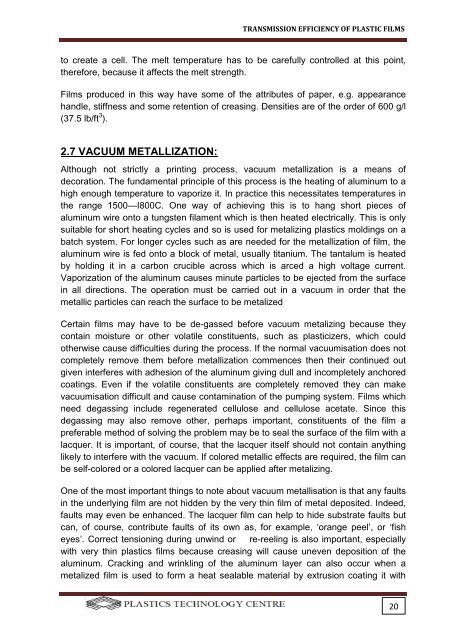Transmission Efficiency of plastic Films Part 1
You also want an ePaper? Increase the reach of your titles
YUMPU automatically turns print PDFs into web optimized ePapers that Google loves.
TRANSMISSION EFFICIENCY OF PLASTIC FILMS<br />
to create a cell. The melt temperature has to be carefully controlled at this point,<br />
therefore, because it affects the melt strength.<br />
<strong>Films</strong> produced in this way have some <strong>of</strong> the attributes <strong>of</strong> paper, e.g. appearance<br />
handle, stiffness and some retention <strong>of</strong> creasing. Densities are <strong>of</strong> the order <strong>of</strong> 600 g/l<br />
(37.5 lb/ft 3 ).<br />
2.7 VACUUM METALLIZATION:<br />
Although not strictly a printing process, vacuum metallization is a means <strong>of</strong><br />
decoration. The fundamental principle <strong>of</strong> this process is the heating <strong>of</strong> aluminum to a<br />
high enough temperature to vaporize it. In practice this necessitates temperatures in<br />
the range 1500—I800C. One way <strong>of</strong> achieving this is to hang short pieces <strong>of</strong><br />
aluminum wire onto a tungsten filament which is then heated electrically. This is only<br />
suitable for short heating cycles and so is used for metalizing <strong>plastic</strong>s moldings on a<br />
batch system. For longer cycles such as are needed for the metallization <strong>of</strong> film, the<br />
aluminum wire is fed onto a block <strong>of</strong> metal, usually titanium. The tantalum is heated<br />
by holding it in a carbon crucible across which is arced a high voltage current.<br />
Vaporization <strong>of</strong> the aluminum causes minute particles to be ejected from the surface<br />
in all directions. The operation must be carried out in a vacuum in order that the<br />
metallic particles can reach the surface to be metalized<br />
Certain films may have to be de-gassed before vacuum metalizing because they<br />
contain moisture or other volatile constituents, such as <strong>plastic</strong>izers, which could<br />
otherwise cause difficulties during the process. If the normal vacuumisation does not<br />
completely remove them before metallization commences then their continued out<br />
given interferes with adhesion <strong>of</strong> the aluminum giving dull and incompletely anchored<br />
coatings. Even if the volatile constituents are completely removed they can make<br />
vacuumisation difficult and cause contamination <strong>of</strong> the pumping system. <strong>Films</strong> which<br />
need degassing include regenerated cellulose and cellulose acetate. Since this<br />
degassing may also remove other, perhaps important, constituents <strong>of</strong> the film a<br />
preferable method <strong>of</strong> solving the problem may be to seal the surface <strong>of</strong> the film with a<br />
lacquer. It is important, <strong>of</strong> course, that the lacquer itself should not contain anything<br />
likely to interfere with the vacuum. If colored metallic effects are required, the film can<br />
be self-colored or a colored lacquer can be applied after metalizing.<br />
One <strong>of</strong> the most important things to note about vacuum metallisation is that any faults<br />
in the underlying film are not hidden by the very thin film <strong>of</strong> metal deposited. Indeed,<br />
faults may even be enhanced. The lacquer film can help to hide substrate faults but<br />
can, <strong>of</strong> course, contribute faults <strong>of</strong> its own as, for example, ‘orange peel’, or ‘fish<br />
eyes’. Correct tensioning during unwind or re-reeling is also important, especially<br />
with very thin <strong>plastic</strong>s films because creasing will cause uneven deposition <strong>of</strong> the<br />
aluminum. Cracking and wrinkling <strong>of</strong> the aluminum layer can also occur when a<br />
metalized film is used to form a heat sealable material by extrusion coating it with<br />
20



